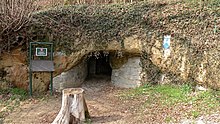
The Great Pyramid of Giza is the largest Egyptian pyramid and served as the tomb of pharaoh Khufu, who ruled during the Fourth Dynasty of the Old Kingdom. Built in the early 26th century BC, over a period of about 27 years, the pyramid is the oldest of the Seven Wonders of the Ancient World, and the only wonder that has remained largely intact. It is the most famous monument of the Giza pyramid complex, which is part of the UNESCO World Heritage Site "Memphis and its Necropolis". It is situated at the northern end of the line of the three pyramids at Giza.

A fogou or fougou is an underground, dry-stone structure found on Iron Age or Romano-British-defended settlement sites in Cornwall. The original purpose of a fogou is uncertain today. Colloquially called vugs, vows, foggos, giant holts, or fuggy holes in various dialects, fogous have similarities with souterrains or earth-houses of northern Europe and particularly Scotland, including Orkney. Fewer than 15 confirmed fogous have been found.

A tunnel is an underground or undersea passageway. It is dug through surrounding soil, earth or rock, or laid under water, and is enclosed except for the entrance and exit, commonly at each end. A pipeline is not a tunnel, though some recent tunnels have used immersed tube construction techniques rather than traditional tunnel boring methods.
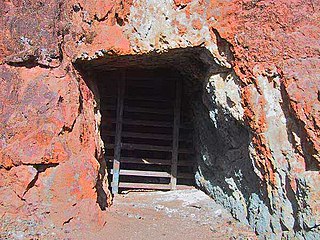
An adit or stulm is a horizontal or nearly horizontal passage to an underground mine. Miners can use adits for access, drainage, ventilation, and extracting minerals at the lowest convenient level. Adits are also used to explore for mineral veins.

The Berlin U-Bahn is a rapid transit system in Berlin, the capital and largest city of Germany, and a major part of the city's public transport system. Together with the S-Bahn, a network of suburban train lines, and a tram network that operates mostly in the eastern parts of the city, it serves as the main means of transport in the capital.

Souterrain is a name given by archaeologists to a type of underground structure associated mainly with the European Atlantic Iron Age.
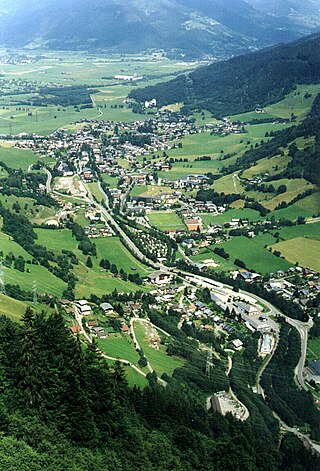
Kaprun is a municipality in the Zell am See District in the province of Salzburg in Austria. Together with the neighboring city of Zell am See the town presents itself as the tourist destination and skiing area "Zell am See-Kaprun". Kaprun distinguishes itself from its larger neighbor at the lake, by offering all year access to the Kitzsteinhorn with its Top of Salzburg viewing platform at 3029m altitude and its glacier ski area that is open October through May.

Timmelsjoch, is a high mountain pass that creates a link through the Ötztal Alps along the border between Austria and Italy.

The Cango Caves are located in Precambrian limestones at the foothills of the Swartberg range near the town of Oudtshoorn, in the Western Cape Province of South Africa. The principal cave is one of the country's finest, best known, and most popular tourist caves and attracts many visitors from overseas. Although the extensive system of tunnels and chambers go on for over 4 km, only about a quarter of this is open to visitors, who may proceed into the cave only in groups supervised by a guide.

Mine exploration is a hobby in which people visit abandoned mines, quarries, and sometimes operational mines. Enthusiasts usually engage in such activities for the purpose of exploration and documentation, sometimes through the use of surveying and photography. In this respect, mine exploration might be considered a type of amateur industrial archaeology. In many ways, however, it is closer to caving, with many participants actively interested in exploring both mines and caves. Mine exploration typically requires equipment such as helmets, head lamps, Wellington boots, and climbing gear.
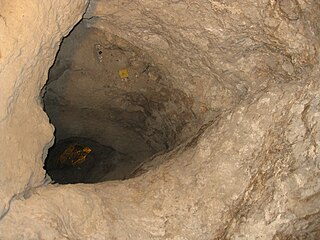
Warren's Shaft is a vertical shaft next to the Gihon Spring, the main source of water of Bronze and Iron Age Jerusalem, discovered in 1867 by British engineer, archaeologist and military officer Charles Warren. The term is currently used in either a narrower, or a wider sense:

Steinbrücken Cave was discovered by the Cambridge University Caving Club on the Loser Plateau in 1999. It is part of the large Schwarzmooskogel cave system, and is named after a nearby natural arch. The arch is in fact a former entrance to Traungold Cave (1623/231e) which has been developed into a convenient bivouac shelter for cave explorers.

Georgian Railway LLC is the national railway company of Georgia.
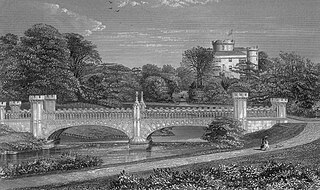
Mysterious tunnels or "secret passages" are a common element of the local folklore tradition in Europe. Such tunnels are said to physically link prominent places such as country houses, castles, churches, ancient monuments and other, often medieval, buildings.

Rennibister Earth House is an Iron Age underground structure known as a souterrain. It is located on the Mainland of Orkney, in Scotland. The monument was discovered in 1926 when a threshing machine caused the roof to collapse. During excavation, the skeletal remains of six adults and twelve children were uncovered. Historic Environment Scotland established the site as a scheduled monument in 1928.

Prandegg Castle is a ruined hill castle in Austria, near the village of Schönau im Mühlkreis in the Freistadt District.
In transport, tunnels can be connected together to form a tunnel network. These can be used in mining to reach ore below ground, in cities for underground rapid transit systems, in sewer systems, in warfare to avoid enemy detection or attacks, as maintenance access routes beneath sites with high ground-traffic such as airports and amusement parks, or to extend public living areas or commercial access while avoiding outdoor weather.

Tunnels are dug in types of materials varying from soft clay to hard rock. The method of tunnel construction depends on such factors as the ground conditions, the ground water conditions, the length and diameter of the tunnel drive, the depth of the tunnel, the logistics of supporting the tunnel excavation, the final use and shape of the tunnel and appropriate risk management. Tunnel construction is a subset of underground construction.

Boybuloq is a limestone cave in Uzbekistan, the deepest cave in Central Asia and all Asia except its western part. The cave is 1,430 metres (4,690 ft) deep and 15,212 metres (49,908 ft) long with the main entrance at an elevation of 2,647 metres (8,684 ft). It is situated at the edge of Baysun-Tau mountain ridge, the southern spur of the Gissar Range, in the southeast of the country. The nearest village is Dehibolo, to the northeast of Boysun.

Underground construction refers to the construction of underground tunnels, shafts, chambers, and passageways, it is also sometimes used to describe the portion of traditional construction that takes place below grade.
